Deep Geothermal Resources with Respect to Power Generation Potential of the Sinian–Cambrian Formation in Western Chongqing City, Eastern Sichuan Basin, China
Abstract
:1. Introduction
2. Methodology
3. Geological Setting
4. Results
4.1. Terrestrial Heat Flow and Geothermal Gradient
4.2. Thermal Conductivity and Heating Conditions
4.3. Types of Deep Geothermal Resources
5. Discussion
5.1. Significant Emphases in the Exploration of Hydrothermal Geothermal Systems within Cambrian Carbonate Formations
5.2. Advantages of Exploring the Anhydrous/Oligohydrous Carbonate Geothermal System in the Sinian System
5.3. The Heat Accumulation Model of Deep Geothermal
5.4. Power Generation Potential of Deep Geothermal Resources
5.5. Prospects for Deep Geothermal Resources
6. Conclusions
Author Contributions
Funding
Data Availability Statement
Acknowledgments
Conflicts of Interest
References
- Barbier, E. Geothermal energy technology and current status: An overview. Renew. Sustain. Energy Rev. 2002, 6, 3–65. [Google Scholar] [CrossRef]
- Randolph, J.B.; Saar, M.O. Combining geothermal energy capture with geologic carbon dioxide sequestration. Geophys. Res. Lett. 2011, 38. [Google Scholar] [CrossRef]
- Li, T.; Zhu, J.; Zhang, W. Cascade utilization of low temperature geothermal water in oilfield combined power generation, gathering heat tracing and oil recovery. Appl. Therm. Eng. 2012, 40, 27–35. [Google Scholar] [CrossRef]
- Wang, K.; Yuan, B.; Ji, G.; Wu, X. A comprehensive review of geothermal energy extraction and utilization in oilfields. J. Pet. Sci. Eng. 2018, 168, 465–477. [Google Scholar] [CrossRef]
- Zhao, P.; Liu, J.; Elsworth, D. Numerical study on a multifracture enhanced geothermal system considering matrix permeability enhancement induced by thermal unloading. Renew. Energy 2023, 203, 33–44. [Google Scholar] [CrossRef]
- Camp, E.R.; Jordan, T.E.; Hornbach, M.J.; Whealton, C.A. A probabilistic application of oil and gas data for exploration stage geothermal reservoir assessment in the Appalachian Basin. Geothermics 2018, 71, 187–199. [Google Scholar] [CrossRef]
- Westphal, D.; Weijermars, R. Economic appraisal and scoping of geothermal energy extraction projects using depleted hydrocarbon wells. Energy Strategy Rev. 2018, 22, 348–364. [Google Scholar] [CrossRef]
- Davis, A.P.; Michaelides, E.E. Geothermal power production from abandoned oil wells. Energy 2009, 34, 866–872. [Google Scholar] [CrossRef]
- Mehmood, A.; Yao, J.; Fun, D.Y. Future electricity production from geothermal resources using oil and gas wells. Open J. Yangtze Oil Gas. 2017, 2, 191–200. [Google Scholar] [CrossRef]
- Nian, Y.-L.; Cheng, W.-L. Insights into geothermal utilization of abandoned oil and gas wells. Renew. Sustain. Energy Rev. 2018, 87, 44–60. [Google Scholar] [CrossRef]
- Gizzi, M. Closed-loop systems for geothermal energy exploitation from hydrocarbon wells: An Italian case study. Appl. Sci. 2021, 11, 10551. [Google Scholar] [CrossRef]
- Cano, N.A.; Céspedes, S.; Redondo, J.; Foo, G.; Jaramillo, D.; Martinez, D.; Gutiérrez, M.; Pataquiba, J.; Rojas, J.; Cortés, F.B. Power from geothermal resources as a co-product of the oil and gas industry: A review. ACS Omega 2022, 7, 40603–40624. [Google Scholar] [CrossRef]
- Raymond, J.; Langevin, H.; Comeau, F.-A.; Malo, M. Temperature dependence of rock salt thermal conductivity: Implications for geothermal exploration. Renew. Energy 2022, 184, 26–35. [Google Scholar] [CrossRef]
- Jello, J.; Baser, T. Utilization of existing hydrocarbon wells for geothermal system development: A review. Appl. Energy 2023, 348, 121456. [Google Scholar] [CrossRef]
- Wallace, R.; Kraemer, T.; Taylor, R.; Wesselman, J. Assessment of geopressured-geothermal resources in the northern Gulf of Mexico basin. US Geol. Surv. Circ. 1979, 790, 132–155. [Google Scholar]
- Rybach, L. Geothermal power growth 1995–2013—A comparison with other renewables. Energies 2014, 7, 4802–4812. [Google Scholar] [CrossRef]
- Liu, J.; Zhao, P.; Peng, J.; Xian, H. Insight into the investigation of heat extraction performance affected by natural fractures in enhanced geothermal system (EGS) with THM multiphysical field model. Renew. Energy 2024, 231, 121030. [Google Scholar] [CrossRef]
- Duggal, R.; Rayudu, R.; Hinkley, J.; Burnell, J.; Wieland, C.; Keim, M. A comprehensive review of energy extraction from low-temperature geothermal resources in hydrocarbon fields. Renew. Sustain. Energy Rev. 2022, 154, 111865. [Google Scholar] [CrossRef]
- Wang, S.; Yan, J.; Li, F.; Hu, J.; Li, K. Exploitation and utilization of oilfield geothermal resources in China. Energies 2016, 9, 798. [Google Scholar] [CrossRef]
- Wang, J.; Hu, S.; Pang, Z.; He, L.; Zhao, P.; Zhu, C.; Rao, S.; Tang, X.; Kong, Y.; Luo, L. Estimate of geothermal resources potential for hot dry rock in the continental area of China. Sci. Technol. Rev. 2012, 30, 32. [Google Scholar]
- Hu, X.; Lv, J.; Li, S.; Du, G.; Wang, Z.; Li, H.; Zhu, H. Joint interpretation technology of favorable HDR geothermal resource exploration in Northern Songliao Basin. Unconv. Resour. 2022, 2, 133–138. [Google Scholar] [CrossRef]
- Huang, X.; Zhu, J.; Niu, C.; Li, J.; Hu, X.; Jin, X. Heat extraction and power production forecast of a prospective Enhanced Geothermal System site in Songliao Basin, China. Energy 2014, 75, 360–370. [Google Scholar] [CrossRef]
- Huang, K.; Gosnold, W.; Hickson, C.; Benoit, D. Using Oil and Gas Data to Assess Geothermal Resources Within the Western Canadian Sedimentary Basin in Alberta. In Proceedings of the GRC Transactions, Virtual Conference, Online, 19–23 October 2020; p. 1364. [Google Scholar]
- Bai, X.; Li, J.; Liu, X.; Wang, R.; Ma, S.; Yang, F.; Li, X.; Liu, J. Evolution of the Anisotropic Thermophysical Performance for Low-Maturity Oil Shales at an Elevated Temperature and Its Implications for Restoring Oil Development. Energy Fuels 2024. [Google Scholar] [CrossRef]
- Zuo, Y.; Sun, Y.; Zhang, L.; Zhang, C.; Wang, Y.; Jiang, G.; Wang, X.; Zhang, T.; Cui, L. Geothermal resource evaluation in the Sichuan Basin and suggestions for the development and utilization of abandoned oil and gas wells. Renew. Energy 2024, 225, 120362. [Google Scholar] [CrossRef]
- Horvath, M.; Kelemen, D.; Fenerty, D.K. Harvesting geothermal from abandoned, superdeep dry holes. Int. Multidiscip. Sci. GeoConference SGEM 2018, 18, 379–384. [Google Scholar]
- Reguzzoni, M.; Sampietro, D.; Sansò, F. Global Moho from the combination of the CRUST2. 0 model and GOCE data. Geophys. J. Int. 2013, 195, 222–237. [Google Scholar] [CrossRef]
- Zhang, Z.; Yao, H.; Yang, Y. Shear wave velocity structure of the crust and upper mantle in Southeastern Tibet and its geodynamic implications. Sci. China Earth Sci. 2020, 63, 1278–1293. [Google Scholar] [CrossRef]
- Gao, J.; Yang, Y.; Huang, S.; Yang, C.; Zhang, Y.; Liu, C.; Li, S.; Hua, Q. Crustal anisotropy and its tectonic implications in the Chongqing region. Seismol. Geol. 2020, 42, 147–162. [Google Scholar]
- Li, F. Seismic Hazard Analysis on the Wide Spaced Anticlines in Chongqing. Master’s Thesis, Institute of Geology, China Earthquake Administration, Beijing, China, 2015. [Google Scholar]
- Wei, L.S.L.Z.S.; Guozhi, D.B.L.Z.W.; Wen, Y.Z.H. Basic geological features of superimposed basin and hydrocarbon accumulation in Sichuan Basin, China. Chin. J. Geol. 2011, 46, 233–257. [Google Scholar]
- Liu, S.; Yang, Y.; Deng, B.; Zhong, Y.; Wen, L.; Sun, W.; Li, Z.; Jansa, L.; Li, J.; Song, J. Tectonic evolution of the Sichuan basin, southwest China. Earth-Sci. Rev. 2021, 213, 103470. [Google Scholar] [CrossRef]
- Wang, Z.; Zhao, W.; Hu, S.; Xu, A.; Jiang, Q.; Jiang, H.; Huang, S.; Li, Q. Control of tectonic differentiation on the formation of large oil and gas fields in craton basins: A case study of Sinian–Triassic of the Sichuan Basin. Nat. Gas. Ind. B 2017, 4, 141–155. [Google Scholar] [CrossRef]
- Fu, Q.; Hu, S.; Xu, Z.; Zhao, W.; Shi, S.; Zeng, H. Depositional and diagenetic controls on deeply buried Cambrian carbonate reservoirs: Longwangmiao Formation in the Moxi–Gaoshiti area, Sichuan Basin, southwestern China. Mar. Pet. Geol. 2020, 117, 104318. [Google Scholar] [CrossRef]
- Liu, D.; Cai, C.; Hu, Y.; Peng, Y.; Jiang, L. Multistage dolomitization and formation of ultra-deep Lower Cambrian Longwangmiao Formation reservoir in central Sichuan Basin, China. Mar. Pet. Geol. 2021, 123, 104752. [Google Scholar] [CrossRef]
- Liu, J.; Yao, Y.-B.; Elsworth, D. Morphological complexity and azimuthal disorder of evolving pore space in low-maturity oil shale during in-situ thermal upgrading and impacts on permeability. Pet. Sci. 2024. [Google Scholar] [CrossRef]
- Luo, B.; Yang, Y.; Luo, W. Controlling Factors of Dengying Formation Reservoirs in the Central Sichuan Paleo-Uplift. Pet. Res. 2017, 2, 54–63. [Google Scholar] [CrossRef]
- Xun, Z.; Yifan, G.; Yuqiang, J.; Tingke, T.; Wei, X.; Kaihong, L. Characteristics and reservoir body classification & evaluation of Sinian Dengying karst reservoirs in the Gaoshiti Block of central Sichuan Basin. Nat. Gas. Ind. 2019, 39, 38–46. [Google Scholar]
- Wang, X.; Wang, J.; Li, Q.; Yu, H. Deep Heat Flow and Geothermal Structure in Sichuan Basin of China, Paper Presented at World Geothermal Congress; International Geothermal Association: Tokyo, Japan, 2000. [Google Scholar]
- Xu, M.; Zhu, C.Q.; Tian, Y.T.; Rao, S.; Hu, S.B. Borehole temperature logging and characteristics of subsurface temperature in the Sichuan Basin. Chin. J. Geophys. 2011, 54, 224–233. [Google Scholar]
- Zhu, C.; Qiu, N.; Chen, T.; Xu, M.; Ding, R.; Yang, Y. Thermal lithospheric thickness of the Sichuan Basin and its geological implications. Acta Geol. Sin.-Engl. Ed. 2022, 96, 1323–1330. [Google Scholar] [CrossRef]
- Xu, Q.; Qiu, N.; Liu, W.; Shen, A.; Wang, X. Thermal evolution and maturation of Sinian and Cambrian source rocks in the central Sichuan Basin, Southwest China. J. Asian Earth Sci. 2018, 164, 143–158. [Google Scholar] [CrossRef]
- Liu, W.; Qiu, N.; Xu, Q.; Liu, Y. Precambrian temperature and pressure system of Gaoshiti-Moxi block in the central paleo-uplift of Sichuan Basin, southwest China. Precambrian Res. 2018, 313, 91–108. [Google Scholar] [CrossRef]
- Yang, P.; Cheng, Q.; Xie, S.; Wang, J.; Chang, L.; Yu, Q.; Zhan, Z.; Chen, F. Hydrogeochemistry and geothermometry of deep thermal water in the carbonate formation in the main urban area of Chongqing, China. J. Hydrol. 2017, 549, 50–61. [Google Scholar] [CrossRef]
- Zhu, C.; Xu, M.; Qiu, N.; Hu, S. Heat production of sedimentary rocks in the Sichuan basin, Southwest China. Geochem. J. 2018, 52, 401–413. [Google Scholar] [CrossRef]
- Tang, B.; Zhu, C.; Xu, M.; Chen, T.; Hu, S. Thermal conductivity of sedimentary rocks in the Sichuan basin, Southwest China. Energy Explor. Exploit. 2019, 37, 691–720. [Google Scholar] [CrossRef]
- Wang, Z.-C.; Zhao, W.-Z.; Li, Z.-Y.; Jiang, X.-F.; Jun, L. Role of basement faults in gas accumulation of Xujiahe Formation, Sichuan Basin. Pet. Explor. Dev. 2008, 35, 541–547. [Google Scholar] [CrossRef]
- Wu, J.; Liu, S.; Wang, G.; Zhao, Y.; Sun, W.; Song, J.; Tian, Y. Multi-stage hydrocarbon accumulation and formation pressure evolution in sinian dengying formation-cambrian longwangmiao formation, gaoshiti-moxi structure, sichuan basin. J. Earth Sci. 2016, 27, 835–845. [Google Scholar] [CrossRef]
- Mgimba, M.M.; Jiang, S.; Mwakipunda, G.C. The identification of normal to underpressured formations in the Southeastern Sichuan basin. J. Pet. Sci. Eng. 2022, 219, 111085. [Google Scholar] [CrossRef]
- Juan, W.; Shugen, L.; Yihua, Z.; Wei, S.; Linke, S.; Jinmin, S. Fluid characteristics of Upper Sinian-Lower Cambrian petroliferous strata in Gaoshiti-Moxi Structure of Sichuan Basin. China. J. Chengdu Univ. Technol. Sci. Technol. Ed. 2014, 41, 713–722. [Google Scholar]
- Ou JQ, W.X.; Yuan, Q. Type identification of water produced from Longwangmiao Fm gas reservoirs in Moxi Block of Anyue Gas Field. Nat. Gas. Explor. Dev. 2017, 40, 58–62. [Google Scholar]
- Awaleh, M.O.; Hoch, F.B.; Boschetti, T.; Soubaneh, Y.D.; Egueh, N.M.; Elmi, S.A.; Mohamed, J.; Khaireh, M.A. The geothermal resources of the Republic of Djibouti—II: Geochemical study of the Lake Abhe geothermal field. J. Geochem. Explor. 2015, 159, 129–147. [Google Scholar] [CrossRef]
- Yang, P.; Dan, L.; Groves, C.; Xie, S. Geochemistry and genesis of geothermal well water from a carbonate–evaporite aquifer in Chongqing, SW China. Environ. Earth Sci. 2019, 78, 33. [Google Scholar] [CrossRef]
- Jiao, F.; Yang, Y.; Ran, Q.; Wu, G.; Liang, H. Distribution and gas exploration of the strike–slip faults in the central Sichuan Basin. Nat. Gas Ind. B 2022, 9, 63–72. [Google Scholar] [CrossRef]
- Jolie, E.; Scott, S.; Faulds, J.; Chambefort, I.; Axelsson, G.; Gutiérrez-Negrín, L.C.; Regenspurg, S.; Ziegler, M.; Ayling, B.; Richter, A. Geological controls on geothermal resources for power generation. Nat. Rev. Earth Environ. 2021, 2, 324–339. [Google Scholar] [CrossRef]
- Yang, X.; Wang, X.; Tang, H.; Yang, Y.; Xie, J.; Luo, W.; Dai, L. The caledonian paleokarstification of longwangmiao formation, lower cambrian in the central Sichuan Basin, China. Carbonates Evaporites 2017, 32, 325–335. [Google Scholar] [CrossRef]
- Liang, J. Characteristics of Favorable Reservoir Facies Belts and Fracture-Hole Identification in Longwangmiao Formation of Gaomo Block. Master’s thesis, Yangtze University, Wuhan, China, 2017.
- Breede, K.; Dzebisashvili, K.; Liu, X.; Falcone, G. A systematic review of enhanced (or engineered) geothermal systems: Past, present and future. Geotherm. Energy 2013, 1, 4. [Google Scholar] [CrossRef]
- Lu, C.; Lin, W.; Gan, H.; Liu, F.; Wang, G. Occurrence types and genesis models of hot dry rock resources in China. Environ. Earth Sci. 2017, 76, 1–19. [Google Scholar] [CrossRef]
- Feng, M.; Wu, P.; Qiang, Z.; Liu, X.; Duan, Y.; Xia, M. Hydrothermal dolomite reservoir in the Precambrian Dengying Formation of central Sichuan Basin, southwestern China. Mar. Pet. Geol. 2017, 82, 206–219. [Google Scholar] [CrossRef]
- Zhou, Z.; Jin, Y.; Zeng, Y.; Zhang, X.; Zhou, J.; Zhuang, L.; Xin, S. Investigation on fracture creation in hot dry rock geothermal formations of China during hydraulic fracturing. Renew. Energy 2020, 153, 301–313. [Google Scholar] [CrossRef]
- Zhang, Y.; Zhang, Y.; Zhou, L.; Lei, Z.; Guo, L.; Zhou, J. Reservoir stimulation design and evaluation of heat exploitation of a two-horizontal-well enhanced geothermal system (EGS) in the Zhacang geothermal field, Northwest China. Renew. Energy 2022, 183, 330–350. [Google Scholar] [CrossRef]
- Kumari, W.; Ranjith, P.; Perera, M.; Li, X.; Li, L.; Chen, B.; Isaka, B.A.; De Silva, V. Hydraulic fracturing under high temperature and pressure conditions with micro CT applications: Geothermal energy from hot dry rocks. Fuel 2018, 230, 138–154. [Google Scholar] [CrossRef]
- Wang, R.; Wang, L. Borehole instability mechanism of sinian dengying formation in central sichuan area and anti-sloughing drilling fluid technology. Drill. Prod. Technol. 2019, 42, 108–111. [Google Scholar]
- Moeck, I.S. Catalog of geothermal play types based on geologic controls. Renew. Sustain. Energy Rev. 2014, 37, 867–882. [Google Scholar] [CrossRef]
- Zarrouk, S.J.; Moon, H. Efficiency of geothermal power plants: A worldwide review. Geothermics 2014, 51, 142–153. [Google Scholar] [CrossRef]
- Montanari, D.; Minissale, A.; Doveri, M.; Gola, G.; Trumpy, E.; Santilano, A.; Manzella, A. Geothermal resources within carbonate reservoirs in western Sicily (Italy): A review. Earth-Sci. Rev. 2017, 169, 180–201. [Google Scholar] [CrossRef]
- Li, J.; Wu, J.; Yang, Z.; Duan, Y.; Yu, Z. Review of geothermal power generation technologies and key influencing factors. Therm. Power Gener. 2022, 52, 1–8. [Google Scholar]
- Anderson, A.; Rezaie, B. Geothermal technology: Trends and potential role in a sustainable future. Appl. Energy 2019, 248, 18–34. [Google Scholar] [CrossRef]
- Xia, L.; Zhang, Y. An overview of world geothermal power generation and a case study on China—The resource and market perspective. Renew. Sustain. Energy Rev. 2019, 112, 411–423. [Google Scholar] [CrossRef]
- Kang, F.; Zhao, J.; Tan, Z.; Sui, H.; Shi, M. Geothermal power generation potential in the eastern linqing depression. Acta Geol. Sin.-Engl. Ed. 2021, 95, 1870–1881. [Google Scholar] [CrossRef]
- Schavemaker, P.; Van der Sluis, L. Electrical Power System Essentials; John Wiley & Sons: New York, NY, USA, 2017. [Google Scholar]
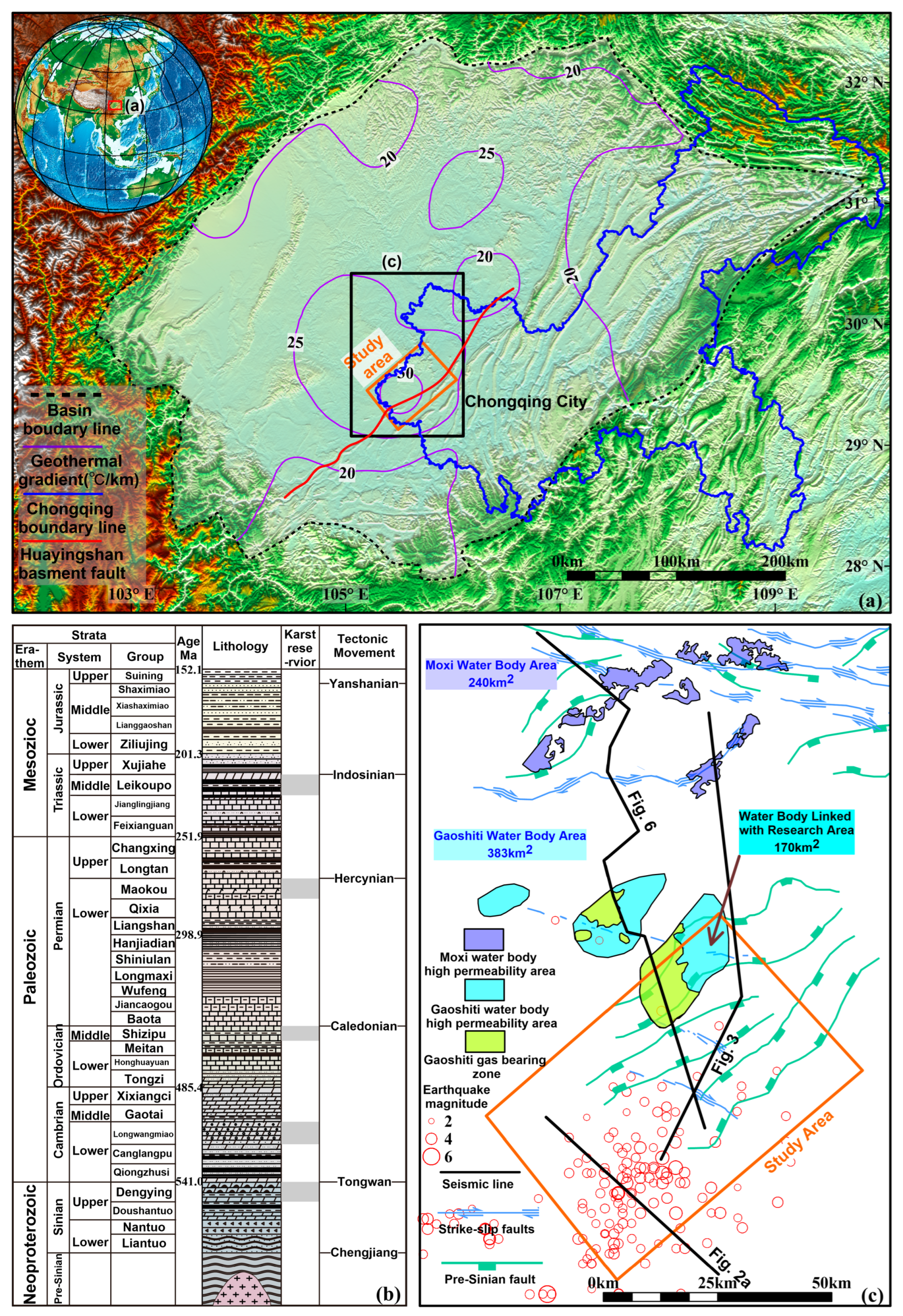

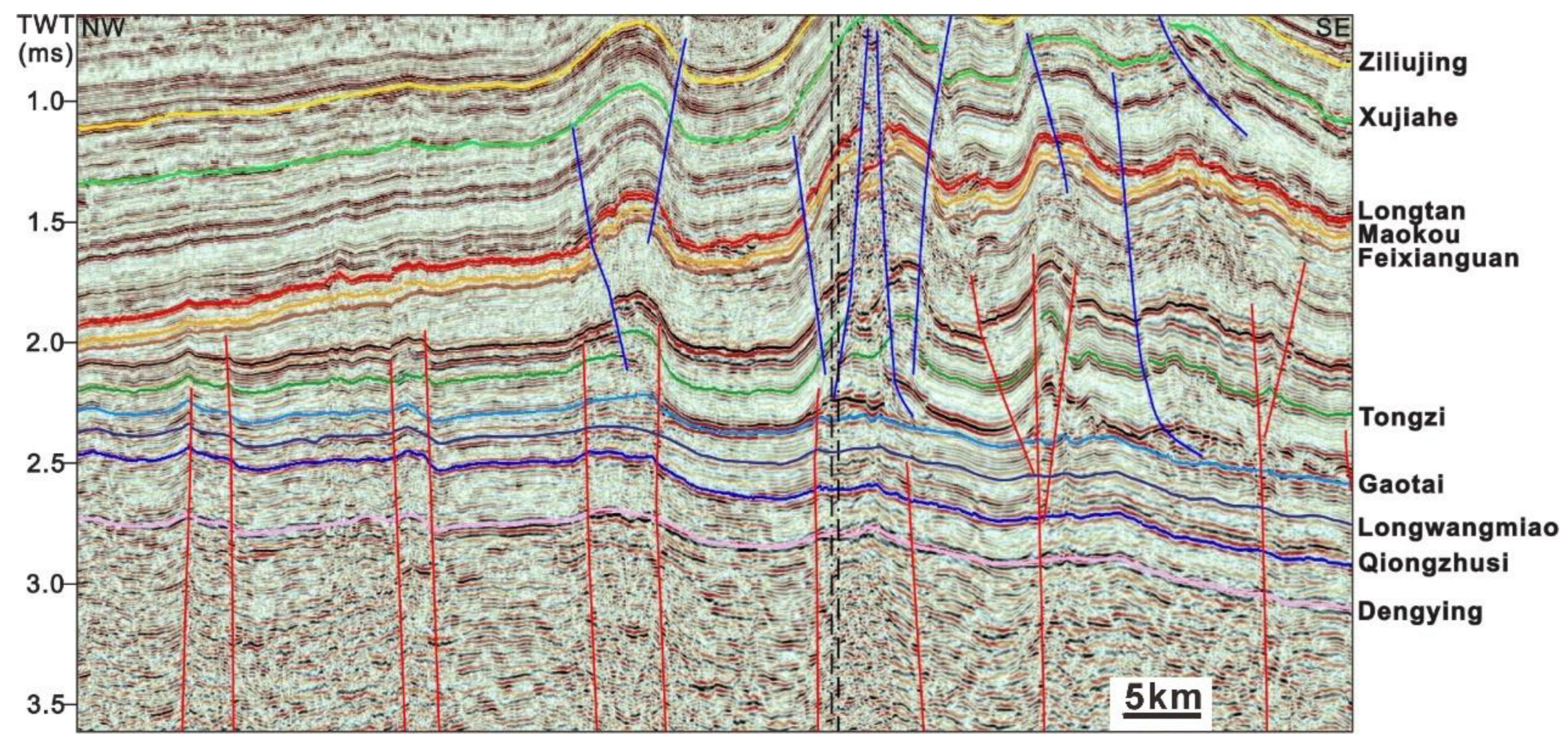
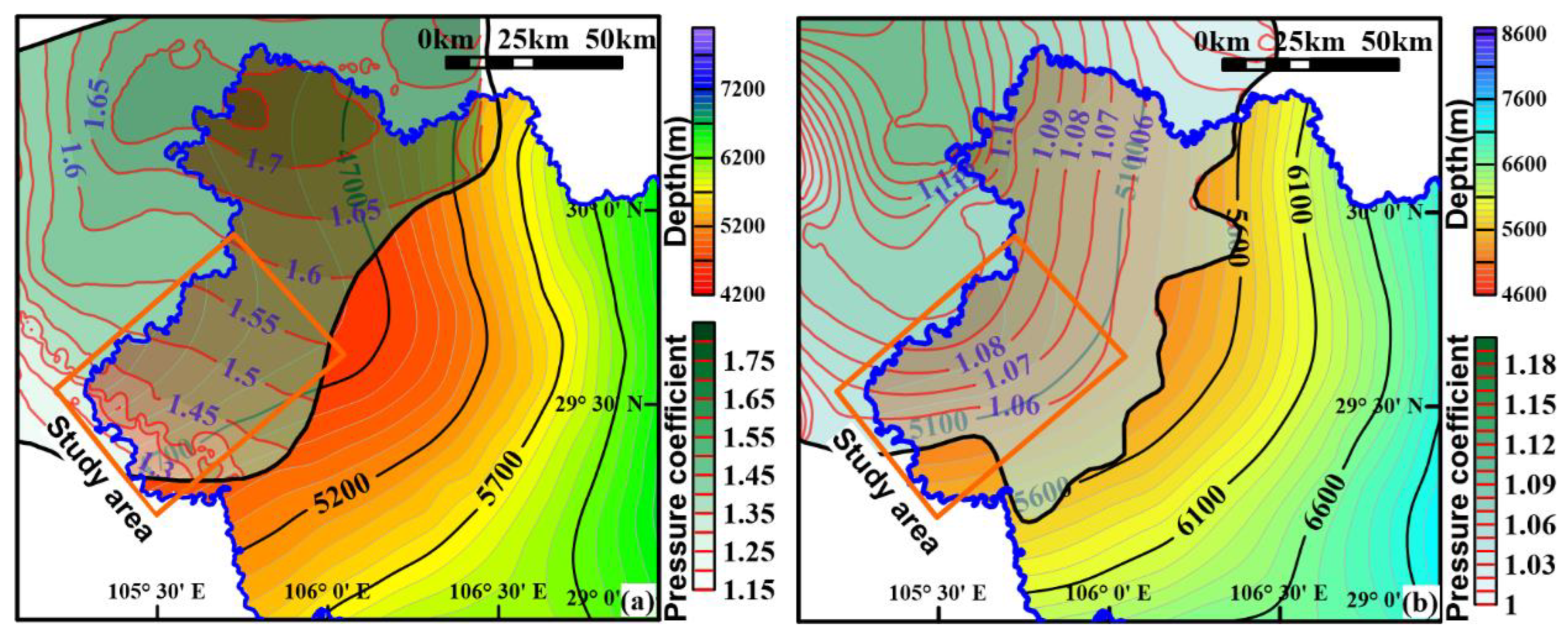
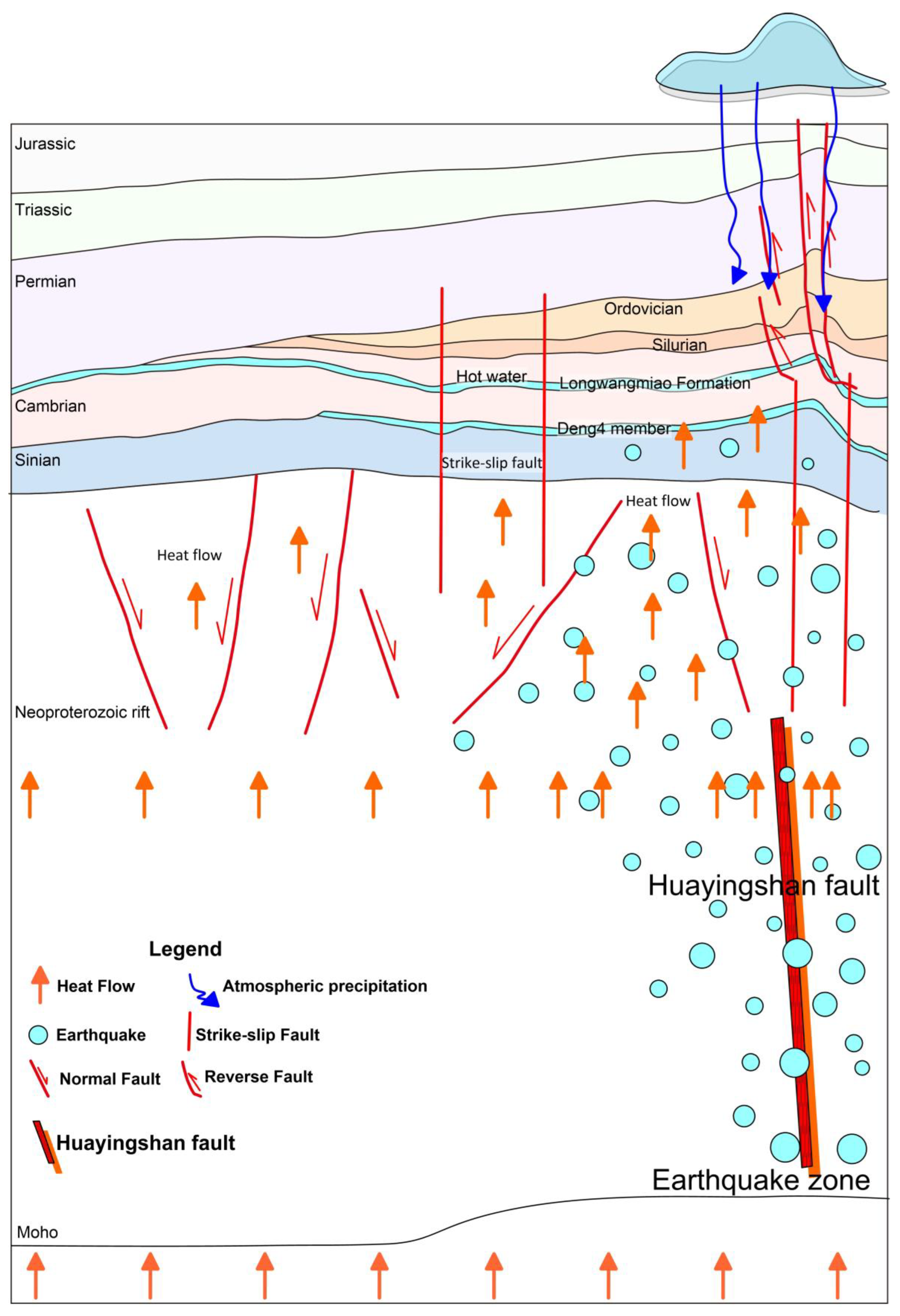
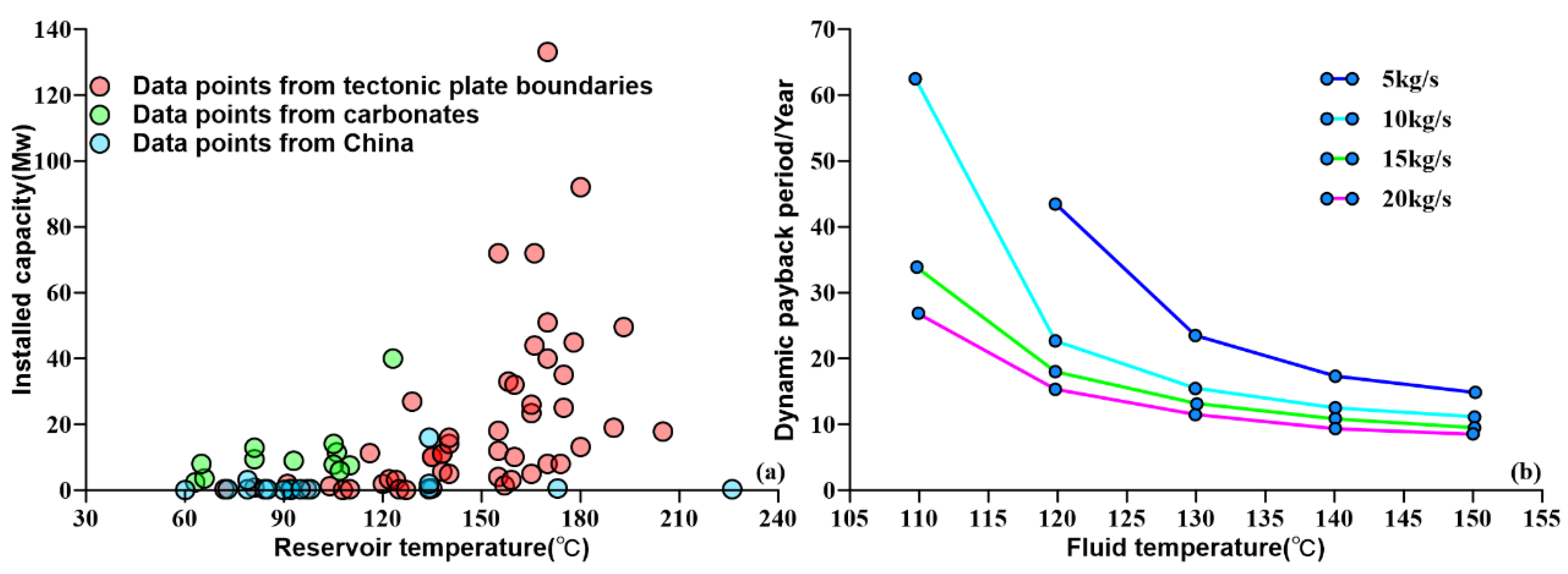
Disclaimer/Publisher’s Note: The statements, opinions and data contained in all publications are solely those of the individual author(s) and contributor(s) and not of MDPI and/or the editor(s). MDPI and/or the editor(s) disclaim responsibility for any injury to people or property resulting from any ideas, methods, instructions or products referred to in the content. |
© 2024 by the authors. Licensee MDPI, Basel, Switzerland. This article is an open access article distributed under the terms and conditions of the Creative Commons Attribution (CC BY) license (https://creativecommons.org/licenses/by/4.0/).
Share and Cite
Wu, X.; Wang, W.; Zhang, L.; Wang, J.; Zhang, Y.; Zhang, Y. Deep Geothermal Resources with Respect to Power Generation Potential of the Sinian–Cambrian Formation in Western Chongqing City, Eastern Sichuan Basin, China. Energies 2024, 17, 4045. https://doi.org/10.3390/en17164045
Wu X, Wang W, Zhang L, Wang J, Zhang Y, Zhang Y. Deep Geothermal Resources with Respect to Power Generation Potential of the Sinian–Cambrian Formation in Western Chongqing City, Eastern Sichuan Basin, China. Energies. 2024; 17(16):4045. https://doi.org/10.3390/en17164045
Chicago/Turabian StyleWu, Xiaochuan, Wei Wang, Lin Zhang, Jinxi Wang, Yuelei Zhang, and Ye Zhang. 2024. "Deep Geothermal Resources with Respect to Power Generation Potential of the Sinian–Cambrian Formation in Western Chongqing City, Eastern Sichuan Basin, China" Energies 17, no. 16: 4045. https://doi.org/10.3390/en17164045





